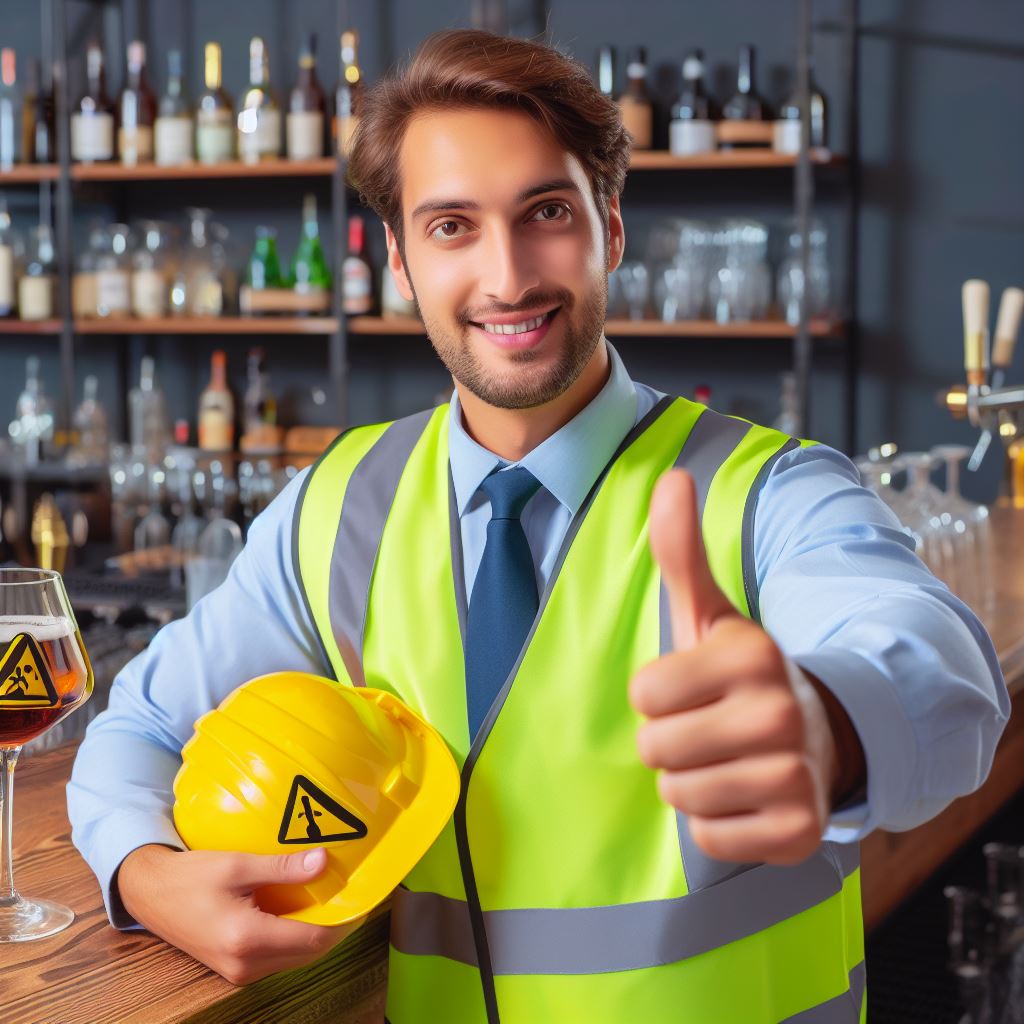Introduction
Workplace safety is a crucial aspect in any industry, and bartending is no exception.
While it may seem like a fun job, bartenders face specific safety concerns that need to be addressed and resolved.
This blog section aims to shed light on the importance of workplace safety for bartenders and explore the specific safety concerns they encounter in their day-to-day work. Let’s dive in.
Importance of workplace safety
Ensuring workplace safety is vital for bartenders to create a secure environment for both employees and customers.
It not only prevents accidents but also promotes employee well-being and job satisfaction.
A safe workplace reduces the risk of injury, protects the reputation of the establishment, and helps maintain high-quality service.
Specific safety concerns for bartenders
Bartenders face unique safety challenges due to the nature of their work.
They constantly handle sharp tools and glassware, increasing the risk of cuts and punctures.
Additionally, they handle potentially harmful chemicals such as cleaning solutions and alcohol, which can lead to chemical burns or intoxication if not handled properly.
Bartenders are also prone to slip and fall accidents due to spills and wet floors, especially during busy shifts.
Moreover, long hours and demanding schedules can contribute to fatigue, increasing the risk of accidents.
Therefore workplace safety plays a critical role in ensuring the well-being of bartenders.
By addressing specific safety concerns like handling sharp tools, chemicals, and preventing slip and fall accidents, employers can create a safe and secure environment for their bartending staff.
It is crucial for establishments to prioritize and implement safety protocols to protect their employees and maintain a high standard of service.
Read: Certifications to Boost Your CSR Career in the USA
Understanding US Standards and Practices
Bartending is a dynamic and fast-paced job that requires bartenders to be constantly aware of their surroundings and potential hazards.
To ensure the safety and well-being of bartenders, the Occupational Safety and Health Administration (OSHA) has set specific standards and practices that must be followed in the United States.
Before diving into the specific OSHA regulations related to workplace safety for bartenders, it is important to have a basic understanding of these standards and practices.
OSHA is a federal agency that operates under the Department of Labor and is responsible for ensuring safe and healthy working environments for all employees.
Overview of Occupational Safety and Health Administration (OSHA)
OSHA’s main objective is to prevent workplace injuries, illnesses, and fatalities by establishing standards and regulations that employers must adhere to.
Transform Your Career Today
Unlock a personalized career strategy that drives real results. Get tailored advice and a roadmap designed just for you.
Start NowThey provide training, education, and assistance to employers and employees to help them understand and comply with these standards.
OSHA Regulations Related to Workplace Safety for Bartenders
There are several OSHA standards that are specifically related to ensuring workplace safety for bartenders.
These include the Hazard Communication Standard, Bloodborne Pathogens Standard, Personal Protective Equipment Standard, and Slips, Trips, and Falls Prevention.
Hazard Communication Standard
- Bartenders must have access to Safety Data Sheets for all chemicals used in the workplace.
- Labels on chemical containers must be clearly written and easily understood.
- Bartenders should be trained on how to handle and use hazardous chemicals properly.
Bloodborne Pathogens Standard
- Bartenders must be provided with personal protective equipment, such as gloves, to prevent exposure to blood or bodily fluids.
- Bartenders should receive training on how to handle and dispose of potentially infectious materials.
- Proper cleaning and sanitization procedures should be followed to prevent the spread of bloodborne pathogens.
Personal Protective Equipment Standard
- Bartenders must be provided with personal protective equipment, such as eye protection and non-slip footwear.
- Employers are responsible for ensuring that the provided protective equipment is in good condition and properly maintained.
- Bartenders should be trained on how to use and maintain personal protective equipment.
Slips, Trips, and Falls Prevention
- Bartenders should keep workspaces clean and free of spills and clutter to prevent slips, trips, and falls.
- Employers should regularly inspect the workplace for potential hazards and take corrective actions.
- Proper training on safe work practices should be provided to bartenders, including how to use step stools and ladders correctly.
Employer’s Responsibility in Ensuring Compliance with OSHA Regulations
It is the responsibility of the employer to ensure compliance with OSHA regulations and provide a safe work environment for bartenders.
Employers must assess workplace hazards, implement necessary safety measures, provide training, and regularly inspect the workplace to identify potential risks.
Most importantly, workplace safety is crucial for the well-being of bartenders.
By understanding and following OSHA standards and practices, employers can create a safe and healthy working environment for bartenders and reduce the risk of accidents and injuries.
Read: Bartending and Technology: US Bars Embracing the Future
Explore Further: How to Write Effective Event Planning Contracts
Preventing Hazards in the Bartending Environment
Identifying common hazards in bars and clubs
- Broken glass on the floor can cause cuts and injuries if not cleaned up promptly.
- Wet surfaces from spilled drinks can lead to slips and falls.
- Excessive noise levels can impact hearing and cause long-term damage.
- Improperly stored chemicals can pose health risks to employees.
- Handling sharp objects like bottle openers and knives can result in cuts and accidents.
Handling glassware and bottles safely
When handling glassware and bottles, it is important to follow these safety practices:
- Always hold glassware from the bottom to prevent accidents such as dropping or breaking.
- Store glassware on sturdy shelves or in racks to avoid falling and breaking.
- Dispose of broken glass properly in designated containers to prevent injuries during disposal.
- Use bottle openers and corkscrews correctly to avoid cuts and puncture wounds.
Proper use of bar tools and equipment
Using bar tools and equipment correctly can help prevent accidents and injuries. Here are some tips:
- Regularly inspect bar tools and equipment for damage or malfunction.
- Ensure that all tools are properly stored in designated areas when not in use.
- Train employees on the safe and correct use of specific tools and equipment.
- Use tools like shakers and blenders with caution to avoid spills and splatters.
Avoiding slips and falls on wet surfaces
Slips and falls can be a common hazard in a bar environment, especially on wet surfaces.
Take these precautions:
- Keep floors dry and immediately clean up spills using proper cleaning supplies and techniques.
- Place warning signs or cones near wet areas to alert staff and customers.
- Use slip-resistant floor mats in areas prone to spills, such as near sinks and bars.
- Regularly check the condition of flooring to ensure it is even and free from hazards.
Preventing burns and cuts
Working behind a bar involves handling hot liquids and sharp objects.
To minimize burn and cut risks:
- Use insulated gloves or towels when handling hot glassware or beverages.
- Properly train employees on the safe handling of knives and other sharp tools.
- Ensure that all cutting surfaces are stable and secure to prevent slips and accidents.
- Have burn ointments and first aid supplies readily available in case of accidents.
Minimizing exposure to hazardous chemicals
Bartenders often come into contact with hazardous chemicals. Follow these guidelines for chemical safety:
- Store chemicals in well-ventilated areas away from food and beverage preparation areas.
- Wear appropriate personal protective equipment when handling chemicals, such as gloves and goggles.
- Dispose of hazardous materials according to local regulations and guidelines.
- Provide training to staff on the proper handling and storage of chemicals to prevent accidents.
Implementing safety protocols and best practices
To maintain a safe working environment for bartenders, it is important to establish safety protocols and practices:
- Regularly conduct staff training sessions on safety procedures and protocols.
- Create an organized and clutter-free workspace to minimize tripping hazards.
- Promote good communication and teamwork among staff to address safety concerns effectively.
- Encourage responsible alcohol service to prevent intoxicated customers from becoming safety hazards.
By implementing these measures, bartenders can work in a safe and secure environment, minimizing the risk of accidents and injuries.
Read: Future of the CSR Profession: U.S. Trends to Watch For
Showcase Your Business Today
Reach thousands of readers actively exploring professional services. Publish your business profile and grow your audience now.
Publish Now
Uncover the Details: Top 10 Classic American Cocktails and Their Histories
Gain More Insights: Top Companies Hiring Data Entry Clerks in the Service Field
Explore Further: Top Tools for Service Industry Admin Assistants
You Might Also Like: Concierge Etiquette: Best Practices for Success
Personal Safety for Bartenders
- Be aware of your surroundings and trust your instincts at all times.
- Ensure proper lighting and visibility in your workspace to deter potential threats.
- Keep your personal belongings secure and within your line of sight.
- Wear appropriate personal protective equipment (PPE) such as non-slip shoes and gloves.
Dealing with unruly or aggressive customers
- Stay calm and composed when faced with aggressive customers.
- Avoid escalating the situation by listening attentively and empathizing with the customer.
- Use verbal de-escalation techniques to diffuse tense situations.
- Remove yourself from the situation if it becomes unsafe and seek assistance from security or management.
Recognizing potential signs of trouble
- Watch out for customers who exhibit excessive aggression, intoxication, or violent behavior.
- Pay attention to sudden changes in a customer’s demeanor or body language.
- Notice if customers are frequently causing conflicts or disturbances in the establishment.
- Trust your instincts and take preemptive measures if you sense potential trouble.
Strategies for defusing tense situations
- Show empathy and understanding towards upset customers to defuse their anger.
- Use effective communication skills and clear, polite language to maintain control.
- Offer alternatives or compromises to reach a satisfactory resolution.
- Involve security or management if the situation escalates and becomes uncontrollable.
Seeking assistance from security or management
- Be familiar with the location of emergency exits and panic buttons in the workplace.
- Call for help immediately if you sense imminent danger or cannot handle a situation alone.
- Follow the workplace’s established protocol for contacting security or management.
- Ensure clear communication about the situation, providing accurate details and descriptions.
Protecting against workplace violence
- Familiarize yourself with your company’s policies on violence prevention.
- Attend relevant training sessions to learn how to handle potential violent situations.
- Implement proper security measures, such as surveillance cameras and controlled entry systems.
- Report any breaches of security or suspicious activities to the appropriate authorities.
Steps to take in case of an emergency
- Stay calm and assess the situation before taking action.
- Follow emergency procedures set forth by your establishment.
- Evacuate the premises if necessary, assisting customers and colleagues as needed.
- Contact emergency services promptly and provide accurate information about the situation.
Reporting incidents to the appropriate authorities
- Contact local law enforcement to report any criminal incidents or threats.
- Provide detailed information about the incident, including dates, times, and descriptions.
- Cooperate fully with authorities during investigations and provide any requested evidence.
- Follow up with management to ensure they are aware of the incident and taking appropriate action.
Managing physical and mental stress
- Take regular breaks to rest and recharge during your shift.
- Practice stress-reducing techniques such as deep breathing or mindfulness exercises.
- Engage in regular physical exercise to help manage stress and maintain overall well-being.
- Seek support from colleagues or professional counselors if stress becomes overwhelming.
Tips for maintaining overall well-being
- Eat a balanced diet and stay hydrated to ensure physical and mental wellness.
- Get sufficient sleep to recharge and be mentally sharp for your work.
- Prioritize self-care activities such as hobbies or spending time with loved ones.
- Find healthy outlets for stress, such as exercise or creative activities.
Recognizing burnout and seeking support
- Be aware of signs of burnout, such as chronic fatigue, irritability, or decreased job satisfaction.
- Talk to a supervisor or manager about your concerns and exhaustion levels.
- Consider seeking support from mental health professionals or employee assistance programs.
- Take time off when needed to rest and rejuvenate, ensuring long-term well-being.
Read: Job Opportunities for Bartenders: Beyond the Traditional Bar
Conclusion
Workplace safety for bartenders is of paramount importance.
It is crucial for bartenders to prioritize their safety and well-being to ensure a healthy work environment.
Recap of Key Points
Throughout this blog section, we have discussed the US standards and practices for workplace safety for bartenders.
We have explored various aspects such as training, equipment, and emergency procedures.
Emphasizing the Significance of Workplace Safety for Bartenders
Workplace safety for bartenders should never be taken lightly.
The potential hazards such as slip and falls, lifting heavy objects, and exposure to hazardous substances can have severe consequences.
Call to Action for Bartenders to Prioritize Their Safety and Well-being
It is essential for bartenders to take proactive measures to prioritize their safety.
This includes attending safety training programs, following proper lifting techniques, wearing personal protective equipment, and reporting any hazards or incidents promptly.
By taking these steps, bartenders can create a safer work environment for themselves and their colleagues.
Remember, safety is not just a responsibility of the employer but also of every individual in the workplace.
[E-Books for Sale]
The Big Book of 500 High-Paying Jobs in America: Unlock Your Earning Potential
$19.99 • 500 High-Paying Jobs • 330 pages
Explore 500 high-paying jobs in America and learn how to boost your career, earn more, and achieve success!
See All 500 High-Paying Jobs of this E-Book
1001 Professions Without a Degree: High-Paying American Jobs You Can Start Now
$19.99 • 1001 Professions Without a Degree • 174 pages
Discover 1001 high-paying jobs without a degree! Unlock career tips, skills, and success strategies for just $19.99!




